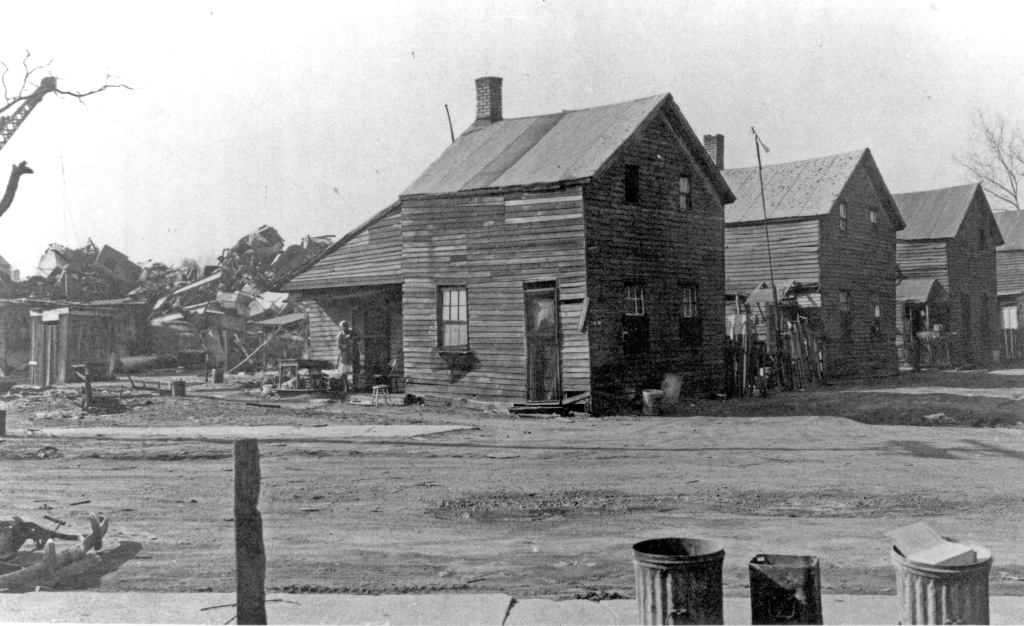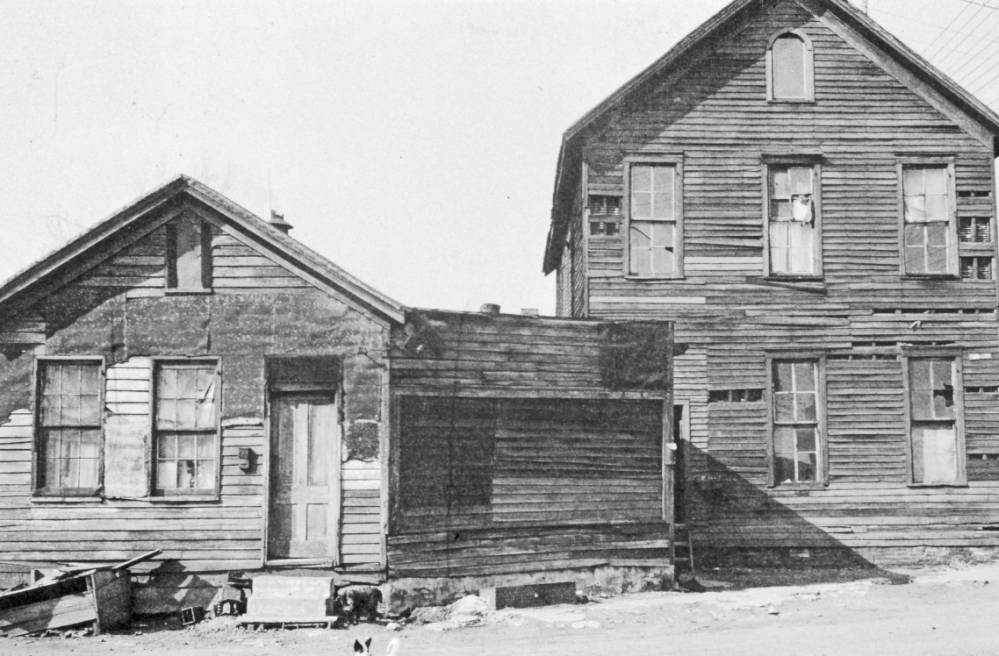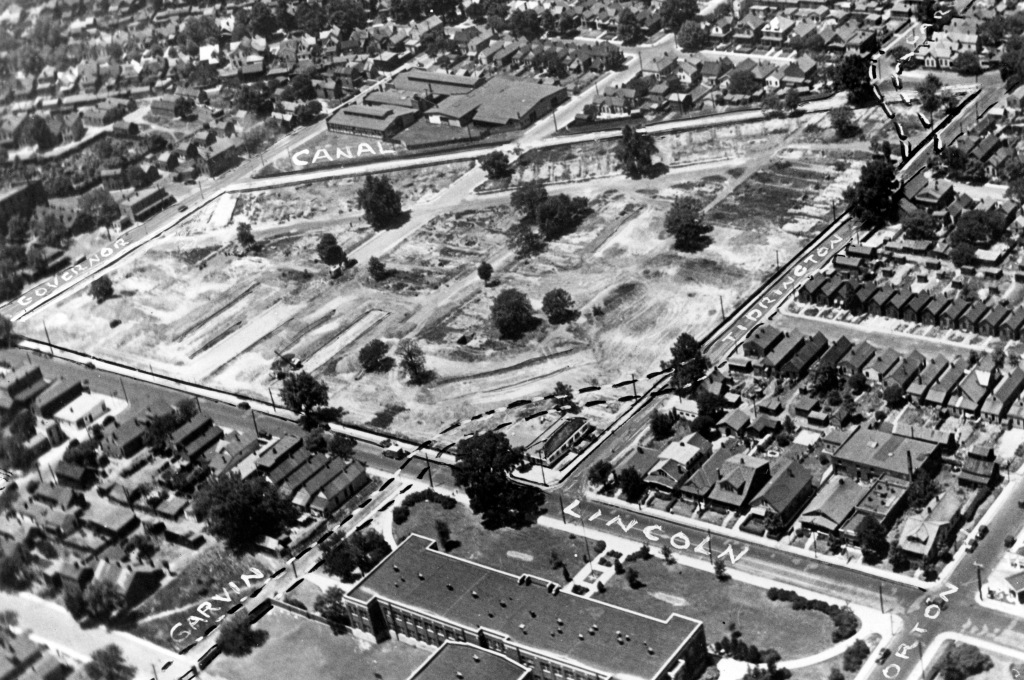
Posted on January 31, 2022 by David L. Rice Library
*Post written by Mona Meyer, Archives and Special Collections Metadata Librarian.

Baptisttown is an old name for an area of Evansville once a primary African American neighborhood. This area corresponds with the city’s 7th Ward, roughly bounded by Governor Street, Canal Street, and Lincoln Avenue. At the turn of the 20th century, segregation laws had forced some 54% of the African American population to live in this area. There were a number of Baptist churches in this area, and the name was originally a pejorative that played on the stereotype of “all blacks as Baptist.” Baptisttown residents, however, co-opted the term for their own and it became a source of pride. “Over 200 businesses, civic organizations, churches, and social clubs located in Baptisttown during its heyday between 1930 and 1960” (i).
An area with a vibrant social and cultural life, yes, but this area had its share of crime and poverty-related problems. “While no group escaped the economic devastation of the Great Depression, few suffered more than African Americans. Said to be “last hired, first fired,” African Americans were the first to see hours and jobs cut, and they experienced the highest unemployment rate during the 1930s. Since they were already relegated to lower-paying professions, African Americans had less of a financial cushion to fall back on when the economy collapsed” (ii). Housing, in particular, was deplorable. The houses seen below are on Days Row, the northeast side of Canal Street, between 10th Street and Governor Street. The surrounding 10 acres was the site of the city’s worst slum. These dwellings appear ready to fall apart. There was no insulation, inadequate or non-existent indoor sanitation, and certainly no central heating. No one would want to live here; no one should have to live here. In addition, the (iii) that “the district was recognized as a breeding ground of crime and epidemics. Its efficiency in filling jails and hospitals was well known. Scarlet fever, diphtheria, malaria, and typhoid fever thrived. Deaths from tuberculosis ran high.”


Top Image: MSS 181-0936 Bottom Image: MSS 181-1348, Darrel Bigham Collection
The area’s housing stock consisted of small structures, many little more than shacks. Most were rental units. At the turn of the twentieth century, only 9 percent of black household heads in Evansville owned their own home, and in the three census districts in Baptisttown with the largest number of African American residents the figure fell to a miniscule 6 percent. Most of those who did own their dwellings belonged to the small black middle class consisting of teachers, barbers, and owners of small businesses who remained in the area because they had few options. … These dilapidated structures generally had no connection to city sewers and most still relied on cisterns for their water supply” (iv). Several efforts over the years to deal with this failed due to financial constraints. But persistence paid off! In 1933 William Best, principal of Lincoln High School (a black school located on the edge of this area) “approached Mayor Frank Griese “to determine if there is a possibility of cleaning up conditions in Baptisttown,” perhaps with federal funds” (v).
One of FDR’s alphabet-soup attempts to put the brakes on the Great Depression was the Public Works Administration. “Language in the 1933 legislation that created the Public Works Administration (PWA) “broke open the door to the nation’s first significant public housing experiment.” The PWA’s Housing Division conducted that experiment, which continued until the advent of the United States Housing Authority in 1937, and it marked “the first direct federal intervention into the housing market in the United States during peacetime.” Over the course of its brief and often controversial existence, the Housing Division was the direct builder of fifty-one projects in thirty-six cities” (vi).
With federal funding now feasible, the City Plan Commission et al immediately conducted a housing survey and worked to garner public support, enabling it to submit a proposal on April 17, 1934. The Housing Division began work on an internal review, and correspondence flowed between interested locals and federal employees. In August, a site visit was conducted, and Evansville was notified that its proposal had made the cut as one that warranted more detailed consideration. More correspondence and documentation were exchanged, and in March 1935 then mayor William Dress and others were informed that “because of the Housing Division’s “sound standards of construction,” it could not set rents low enough to be “satisfactory for the income group we are trying to rehouse in Evansville.” Since the city had a “limited group of families of sufficient income to meet our rents,” federal officials had deemed it “inadvisable to make final disposition of the Evansville project” for the time being. Proponents should not, however, “abandon all hope”” (vii). Negotiations resolved this issue, and the project was back on track.
There was one final hurdle to cross. Early on there had been debate as to where to build this new housing. Some felt that it was cheaper to use undeveloped land on the outskirts of town, while others argued for replacing sub-standard housing in the same location. The second argument won the day; now, what to do with those who would be displaced during the demolition and construction? Options for dealing with this were ironed out, supported by cooperation with the YMCA. “The final few months of 1935 witnessed a flurry of activity. The Housing Division required that its projects have a local advisory committee, and Mayor Dress had named such a group in May. The eleven members included several businessmen (including [industrialist Richard] Rosencranz, who became chairman of the committee, and A. W. Hartig, who served as its secretary), the city’s superintendent of schools, a judge, a minister, and the president of Evansville College. Two members represented the African American community: Dr. Raymond King, a dentist, and Mrs. L. A. George, a Lincoln High School teacher who had been involved in anti-tuberculosis and child welfare work. In December, officials in Washington approved the plans submitted by the consortium of local architects, and an Evansville company received the contract to demolish buildings in the Lincoln Gardens area” (viii).

The Chicago firm of A. Smith and Company won the construction contract with a bid of $483,333. The land cost $161,480.40 and the foundations $70,335.85. Superstructure costs, architects’ fees, and administrative expenses brought the total to $715,148 (ix). What about those concerns with the original cost making rental costs prohibitive? They were lowered by switching from a brick exterior to a brick veneer, and by eliminating a central heating plant in favor of individual heating stoves. Additional economies of scale were had by increasing the number of units to 191 in 16 buildings, instead of the original 138 units in 12 buildings (x).

By January 16, 1938, the project was 65% complete (xi), with full occupancy expected by June 17 (xii). The cornerstone was laid April 23, 1938. Mrs. L.A. George, a teacher at Lincoln and active participant in the planning process, called it “a requiem to the dead –the old Baptisttown. Today is one of the happiest days of our lives. It marks the building of a different set of men in the colored race, boys and girls who will see beauty in the project and rise to it. Give us more schools, teachers, and slum clearance like this, and we won’t ask anything else (xiii). The Evansville Argus, a black newspaper, carried the glad news of Lincoln Gardens’ grand opening on July 1, 1938. “The apartments are made of 2-3 and 4 rooms that rent from $10.95 to $14.95 per month for the 2 rooms, $16.40 and $18.70 for the 3 rooms, and $19.35 to $23.35 for the 4 rooms. [These] rates include electricity for lights and refrigeration, gas for cooking purposes and hot water. Each apartment has an individual heater. … There are 191 apartments that include 40, 2 rooms; 121, 3 rooms and 30, 4 rooms. Each apartment comes equipped with an individual coal bin” (xiv). Another newspaper provided further information: the ceilings were white, the walls gray, the floors hardwood in the living and bedrooms, with ceramic tile in the bathroom (which included a lavatory and tub), and Havana brown linoleum flooring in the kitchen. The kitchen included the gas hot water heater, electric refrigerator, gas stove, built-in work table and cabinets, and a built-in combination sink and laundry (xv).


The local manager for Lincoln Gardens was Dr. Raymond B. King, a graduate of Indiana University School of Dentistry. “Dr. King is well-known in civic affairs of Negroes in Evansville and was an active worker with the Red Cross during the flood of 1937. He has been a member of the Evansville Advisory Committee on Housing and was particularly active in the development of Lincoln Gardens.” King was responsible for choosing which of the applicants would live in Lincoln Gardens (xvi). By July 1, 1938, there were 300 applicants, with only 65 chosen (xvii). “The government employed several criteria in the selection of residents. An applicant’s “fidelity and character” had to be “well established.” The federal George-Healey Act of 1936 specified that families would be eligible only if they currently lived in substandard housing and their monthly income did not exceed five times the rent (or six times for families with three or more minor dependents). … Low income, however, did not mean no income. As Dr. King explained several months later, “public housing is for poor people, yes, but for the poor who show some sign of being able to pay rent regularly” (xviii).

The final family moved into its apartment on December 20, 1938. In total, 509 applications were received, 262 approved. Tenant annual incomes ranged from $584 to $1,407, with 39.8% of families representing WPA employment (xix). Although not without its naysayers, Lincoln Gardens was well regarded when it was established, but fast forward through the decades and this is no longer the case. By the 1990’s it had fallen into disrepair, and eventually all but one unit was demolished. That unit was upgraded and remodeled into the Evansville African American Museum. Within the museum is a full-size model of one of the apartments: living room, bedroom, and kitchen. The full text of the historical marker reads: “African Americans settled in Evansville in the early 1800’s and established a vibrant community here in Baptisttown by 1890. Segregation and discrimination led to a section of overcrowded, dilapidated buildings. With citizen support, city officials applied for New Deal funding to clear part of this area in the 1930s and develop a federal housing project, Lincoln Gardens. Opened in 1938, Lincoln Gardens provided low-cost housing managed by and for African Americans. During World War II, occupants started a club for African American service members barred from the local USO. Lincoln Gardens served as a community center for decades. Saved from demolition, this building opened as the Evansville African American Museum in 1999.”
The story of Lincoln Gardens does not end here. Be sure to read “A Baptisttown Requiem,” part 2 when it is published.
Reference Consulted
Posted on February 16, 2022 by David L. Rice Library
*Post written by Mona Meyer, Archives and Special Collections Metadata Librarian.
Although vitally important, housing isn’t enough to improve a community. As needed as Lincoln Gardens was, its very existence alone was insufficient to alleviate Baptisttown’s problems. Fortunately, Lincoln Gardens had a neighbor that was deeply invested in its success.

Directly across the street was Lincoln High School at 635 Lincoln Avenue. Built in 1927-1928, it “was the first new school in Evansville built for the black minority community. The school cost $275,000 to build. The school included twenty-two classrooms, a gymnasium, auditorium, sewing room, home economics kitchen, study hall, and manual training center. However, Lincoln didn’t have a cafeteria. The library had no books and the board refused to allocate money for that purpose. To stock the library, Mrs. Alberta K. McFarland Stevenson, Lincoln’s first librarian, went door to door collecting books and money donations. Classes were first begun in 1928. It was a K-12 school. Since Lincoln was the only black high school for miles around, black students from Mt. Vernon, Rockport, Newburgh, and Grandview were bussed to Evansville to attend Lincoln. In 1928, the enrollment was over 300” (i).

Granted, Lincoln was a segregated school, and clearly it wasn’t supported financially as well as non-black schools. (This librarian author is particularly incensed about not allocating money to purchase materials for the library!) What it did have was pride. It had been in operation for about 10 years when Lincoln Gardens was built, and the African American community loved and supported the school. The school had dedicated and forward-thinking teachers and administrators, one of whom was then principal W.E. Best. Dr. William Ebenezer Best (1884-1959), was the first principal of Lincoln School, 1928 to 1951. According to his obituary, Best joined the local school system in 1913 and was formerly principal of Douglass High School. He graduated from Indiana State University, earned a masters from Indiana University, and was granted an honorary doctorate from Wilberforce University.
Best initially “conceived the plan of using Lincoln Gardens as the spark to ignite interest of his people in improved living conditions. Three-fourths of the city’s Negro population of 6,500 lived in the slum area of Baptisttown prior to inauguration of the better housing project” (ii). The first manifestation of this idea was seen at Lincoln’s 1938 graduation ceremony. The theme of the commencement was Lincoln Gardens as a stepping-stone to a better future. In addition to the main speaker, four student speakers discussed “Housing as Related to Citizenship.” They included:
In the fall this idea was incorporated into a complete 16-unit curriculum taught at Lincoln. Each unit was taught as part of some related class already established in the curriculum. Related classes were in the social sciences, health, home economics, industrial arts, science, mathematics, and bookkeeping. There was a plan underway to get permission to use one apartment for demonstration purposes. The foundation was to be laid in the 8th grade social science class, which included “material about early housing attempts and traces the awakening of public interest in housing through modern surveys and legislation. Economic and social aspects of large-scale housing are studied somewhat in detail.” Practical lessons covered studying the relationship between sanitary facilities and possible quarantines, how to maintain a clean and orderly household, basic electricity issues like changing fuses, etc., how to do basic plumbing like shutting off water and fixing leaks, handyman chores, and basic “scientific principles incorporated in the apartment units. This [included] mechanical refrigeration, construction features, heating, and ventilating. …We are attempting to make a practical application of classroom work, and we feel that this course of study will help tenants get the most from the use of their new apartments” (iv). If this seems like very basic knowledge that should already be known, take another look at the housing that some Lincoln Gardens’ residents had lived in previously. If this was the only sort of housing you and your family had ever known, how could you know anything about efficient heating? Indoor plumbing? Cleaning your windows?

Best also intended this as “a challenge to the Lincoln faculty, to raise living standards of Evansville’s Negro people to a much higher plane by inculcating permanent ideals into the coming generation.” What might be considered the capstone classes were taught in two 12th grade “American Problems” classes, which included dealing with community relationships. Evidently the then new educational theory of learning by doing met with approval. “An outline of the 17 study units of the new course on housing, built around every-day living problems and largely demonstrated right in the Gardens, has been released throughout the country by the U.S. Housing authority. The release quotes an Indiana University professor who expressed the possibility that the course may be incorporated in the curricula of all public schools.” The article also indicated that a U.S. Department of the Interior representative was expected to visit soon “to designate an apartment of Lincoln Gardens for use of the school in teaching the new course” (v).

Another example of the close connection between the school and the community is this row of houses directly across Lincoln Avenue from the school. Many of these were owned by Lincoln faculty. From the left are Alfred (taught Latin, science, and music at Lincoln for 37 years) and Phoebe Porter’s house, Thomas (Lincoln faculty and coach) and Pauline Cheeks’ house, Boyd Henderson’s house, William (Lincoln principal) and Helen Best’s house, and Raymond (dentist and Lincoln Gardens administrator) and Bessie King’s house.
Our requiem for Baptisttown ends here, with the twin pillars of housing and education serving to revitalize the community. Forward strides have been made, but the struggle for quality housing and quality education for everyone continues.
Reference Consulted
 This work is licensed by the David L. Rice Library under a Creative Commons Attribution-ShareAlike 4.0 International License.
This work is licensed by the David L. Rice Library under a Creative Commons Attribution-ShareAlike 4.0 International License.